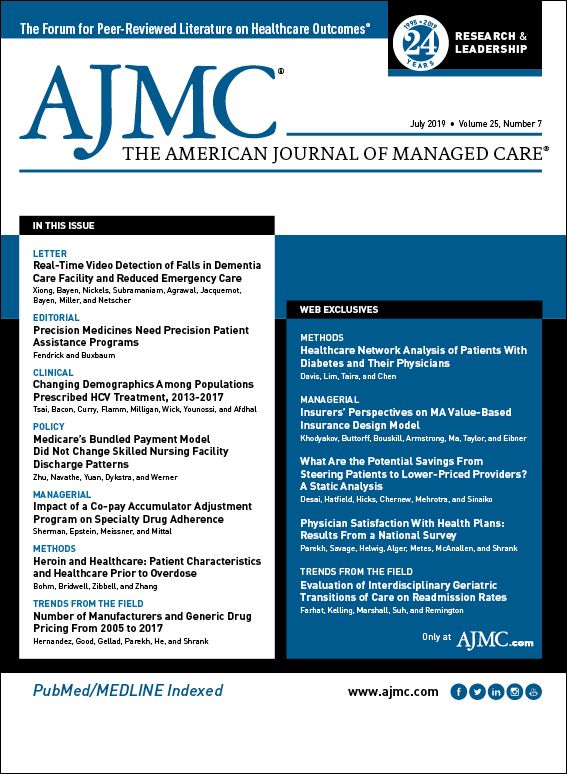Publication
Article
The American Journal of Managed Care
Changing Demographics Among Populations Prescribed HCV Treatment, 2013-2017
Author(s):
From 2013 to 2017, the population of US patients prescribed treatment for chronic hepatitis C virus (HCV) changed, becoming predominantly treatment-naïve and having received care in nonacademic centers.
ABSTRACT
Objectives: We analyzed the demographics and disease characteristics of patients prescribed treatment for chronic hepatitis C virus (HCV) infection from 2013 through 2017, a time frame that encompasses the expansion of available direct-acting antiviral inhibitors.
Study Design: Retrospective analysis.
Methods: Using a proprietary disease-management program, data for 19,944 patients receiving HCV treatment were collected from providers and specialty pharmacies. Six-month time periods accounting for introductions of novel treatments were established as follows: December 2013 to May 2014 (n = 1438), simeprevir and sofosbuvir; October 2014 to March 2015 (n = 2242), ledipasvir/sofosbuvir and ombitasvir/paritaprevir/ritonavir plus dasabuvir; October 2015 to March 2016 (n = 5514), daclatasvir; July 2016 to December 2016 (n = 5562), elbasvir/grazoprevir and sofosbuvir/velpatasvir; and July 2017 to December 2017 (n = 5188), sofosbuvir/velpatasvir/voxilaprevir and glecaprevir/pibrentasvir. Changes over time were evaluated for statistical significance.
Results: In the 2013-2014 time period, 44% of patients receiving prescriptions for HCV treatment were treatment-experienced and 45% had cirrhosis. By 2017, only 14% were treatment-experienced (P <.001) and 21% had cirrhosis (P <.001). The percentage of patients with HCV genotype 1 increased from 69% to 87% from 2013-2014 to 2014-2015 (P <.001) but subsequently decreased to 74% in 2017 (P <.001). The percentage of patients receiving HCV prescriptions in an academic setting declined from 61% in 2013-2014 to 13% in 2017 (P <.001).
Conclusions: In the United States, since the introduction of interferon-free HCV regimens, the patient population prescribed treatment has changed, becoming predominantly treatment-naïve, without cirrhosis, and treated in nonacademic centers.
Am J Manag Care. 2019;25(7):319-323Takeaway Points
Data from a network of providers and specialty pharmacies in the United States suggest that since the introduction of interferon-free treatments for chronic hepatitis C virus (HCV), the population receiving prescriptions has changed.
- There has been a shift toward lower percentages of patients being treatment-experienced, having cirrhosis, or receiving care in academic centers. Although these changes were expected, published data were lacking.
- As sites of care shift to nonacademic centers, there will be increased need to educate public health providers on screening, diagnosis, and treatment for HCV.
Chronic hepatitis C virus (HCV) infection affects approximately 2.7 million individuals in the United States1 and is associated with substantial morbidity and mortality. Liver-related complications of chronic HCV infection include cirrhosis, liver failure, and hepatocellular carcinoma.2 Treatment that results in a sustained virologic response reduces the risk of liver-related complications and can lead to regression of hepatic fibrosis.3 Prior to 2013, all treatment options for chronic HCV required peginterferon and ribavirin for 24 or 48 weeks and had limited efficacy with significant tolerability issues. Since 2013, the HCV treatment landscape has dramatically changed with the expansion of available direct-acting antiviral (DAA) inhibitors, providing multiple options for relatively short (8-12 weeks), simple (once-daily oral tablets), and better-tolerated regimens with high efficacy rates.4 From 2013 to 2017, 13 DAA inhibitors for HCV received approval from the FDA for use in 8 all-oral combination regimens.5 The first all-oral regimens contained simeprevir and sofosbuvir with ribavirin for HCV genotype 1 for up to 24 weeks, but the more recently approved regimens are pangenotypic and 8 or 12 weeks in duration.6,7
As treatment options expanded and improved, there was an expectation that the patient population initiating treatment for chronic HCV would shift from an older, treatment-experienced population with more fibrosis to a younger, treatment-naïve population with milder liver disease. However, there has been a lack of investigation into the specific demographics and disease characteristics of DAA-prescribed patients relative to the availability of different DAA regimens. Using data from a network of providers and specialty pharmacies in the United States, we evaluated changes in patient demographics and practice settings from 2013 to 2017.
METHODS
Data Collection
Clinical, demographic, prescription, and dispensing data for adult (≥18 years) patients with HCV were collected from specialty pharmacies and physicians in the United States through Trio Health’s proprietary Innervation Platform, a portal for managing patient information. Where mandated by state law, patients signed an electronic informed consent allowing data collection. Each clinician and specialty pharmacy providing data signed agreements attesting to compliance with all rules and regulations regarding the disclosure of patient information to a shared database. Embedded in the data collection process are quality control assessments that identify potential errors within fields (eg, data type mismatches, unit conversion errors) and between fields (eg, sequential order of events, improbable combinations of vital or laboratory measures). Data identified as questionable are routed back to the source for confirmation or correction. This data collection process and study plan were approved by Western Institutional Review Board as an institutional review board exemption under 45 CFR 46.101(b)(4).
The analysis population included patients from the 50 US states plus Washington, DC, who were prescribed care for HCV from 1 of 2827 providers and were serviced by 1 of 16 specialty pharmacies.
Analyses
Six-month evaluation periods that spanned the introductions of treatment options were established as follows: December 2013 to May 2014 (n = 1438), inclusive of simeprevir and sofosbuvir availability; October 2014 to March 2015 (n = 2242), inclusive of ledipasvir/sofosbuvir and ombitasvir/paritaprevir/ritonavir plus dasabuvir availability; October 2015 to March 2016 (n = 5514), inclusive of daclatasvir availability; July 2016 to December 2016 (n = 5562), inclusive of elbasvir/grazoprevir and sofosbuvir/velpatasvir availability; and July 2017 to December 2017 (n = 5188), inclusive of sofosbuvir/velpatasvir/voxilaprevir and glecaprevir/pibrentasvir availability (Figure). All statistical analyses were conducted using SPSS 25 (IBM Corp; Armonk, New York) or JMP 14.2 (SAS Institute Inc; Cary, North Carolina). Differences between periods were assessed in SPSS 25 using χ2 (categorical variables) or Kruskal-Wallis (continuous variables) tests with Bonferroni correction for repeated measures. Column (period) proportions for categorical variables were subsequently analyzed using Z tests with Bonferroni correction. Trends were evaluated using either the Cochran-Armitage (linear trends for proportions; JMP 14.2) or Jonckheere-Terpstra (ordered trends for continuous or ordinal variables; SPSS 25) test.
RESULTS
Patient Characteristics
A total of 19,944 patients who were prescribed anti-HCV therapies were included in the analysis. From 2013 through 2017, the mean age of patients receiving prescriptions varied between periods but did not change appreciably (range, 56-58 years) (Table). In 2013-2014, 44% of patients in this cohort were treatment-experienced and 45% had cirrhosis. By 2017, 14% of patients were treatment-experienced (P <.001) and 21% had cirrhosis (P <.001). The percentages of patients with cirrhosis were comparable between the 2016 and 2017 time periods (20% vs 21%). At all time periods analyzed, the majority of patients had HCV genotype 1 (range, 69%-87%). Significant linear trends were identified for HCV genotype proportions and were evident starting from the second evaluation period (2014-2015). The percentage of patients with HCV genotype 1 increased from 69% to 87% from 2013-2014 to 2014-2015 (P <.001) but subsequently decreased to 74% in 2017 (P <.001). The percentages of patients with genotypes 2 and 3 decreased from 19% and 10% to 6% and 5%, respectively, from 2013-2014 to 2014-2015, and they subsequently increased to 12% and 11% in 2017.
Treatment Sites
In the Trio Network, the percentage of providers from academic practices dropped from 32% in 2013-2014 to 12% in 2017 (P <.001), and the percentage of patients receiving HCV prescriptions in an academic setting declined from 61% to 13% (P <.001). These changes translate into a decrease from 12 patients per academic provider (in a 6-month period) to 4 patients per academic provider (P <.001). For the corresponding periods, the average count of patients per community provider remained largely stable at 3.6 to 3.8 (P = .412), although the percentage of providers from community settings increased from 39% to 87% (P <.001). The change in site of care was greatest between the 2014-2015 and 2015-2016 evaluation periods; the proportion of patients treated in an academic setting decreased from 48% to 17% (P <.001).
Insurance Type
Among patients prescribed HCV treatments, the percentage of patients with Medicaid coverage was 24% during both the 2013-2014 and 2017 time periods, although during the intervening periods there was some variation. Overall, there was a decline in the percentage of patients who were commercially insured (51% in 2013-2014 to 30% in 2017; P <.001), and the largest decline occurred between the 2014-2015 (56%) and 2015-2016 (33%) time periods (P <.001). The percentages of patients reporting Medicare as their primary insurer increased from 24% in 2013-2014 to 42% in 2017 (P <.001), with the largest shift occurring between the 2014-2015 (26%) and 2015-2016 (48%) time periods (P <.001).
DISCUSSION
In this study of patients receiving prescriptions for HCV treatment from 2013 to 2017, there was a substantial decline in treatment-experienced patients with cirrhosis and a corresponding increase in treatment-naïve patients predominantly without cirrhosis. The percentages of patients with cirrhosis who received prescriptions for HCV treatment leveled out in 2016 and 2017 at approximately 20%. Our data are consistent with data from the German Hepatitis C Cohort (N = 2367), which indicated decreases in percentages of treatment-experienced patients (83% vs 24%) and patients with cirrhosis (42% vs 17%) from February 2014 to September 2017.8 Similarly, among commercially insured patients in the US administrative claims IQVIA PharMetrics Plus Database who received treatment for HCV, from 2014 to 2017 there was a decline in the percentage of patients having advanced liver disease (29% to 24%).9
In our data, genotype distribution did change significantly from 2013-2014 to 2017, although in each period the majority of patients had HCV genotype 1 (range, 69%-87%). The percentage of patients with HCV genotype 1 peaked in the 2014-2015 period, coincident with the launch of ledipasvir/sofosbuvir in October 2014. The peak may reflect “warehousing” of patients waiting for an all-oral, ribavirin-free regimen with high efficacy against HCV genotype 1.10
In addition to changing demographics, this study found a significant shift toward care in community sites versus academic centers, with the largest change occurring between the 2014-2015 and 2015-2016 periods. In 2014-2015, 48% of the patients were treated in academic centers compared with 17% in the 2015-2016 period. At the same time, the largest observed shifts occurred in the percentages of patients with cirrhosis (37% in 2014-2015 to 26% in 2015-2016) and treatment-experienced patients (38% in 2014-2015 to 21% in 2015-2016). These shifts suggest that the movement to community care may have been driven in part by the reduced number of patients with cirrhosis or prior treatment failure, which are characteristics historically associated with harder-to-treat HCV.11
Although the percentage of Medicaid recipients has stayed relatively stable, there has been an increase in Medicare-covered patients and a corresponding decline in those with commercial insurance. After the first all-oral DAA regimens became available, restrictive payer policies limited treatment access for patients with Medicaid or commercial insurance.12-15 The denial of care for Medicaid-covered patients was nearly instantaneous in the Trio Network, occurring mid-2014, 6 months after the first DAA approval.16 Denial rates for commercially covered patients increased rapidly between the 2014-2015 and 2015-2016 time periods.16 The observed trends reported here suggest that high denial rates subsequently led to the avoidance of prescriptions for patients with Medicaid or commercial coverage.
Limitations
Our analysis has several limitations. First, the data were captured from a limited number of sources and may not reflect trends in the United States as a whole. In addition, the specialty pharmacies and providers from which data were captured changed over time, and therefore we cannot rule out the possibility that the changes we saw were a result of differential sampling over time. Populations that were not represented or were underrepresented in the study included those receiving care in drug addiction treatment centers or correctional institutions. Race, which is patient-reported and patient-consented in the Trio Network, was specified for 38% of the data set. Based on patient reporting, the composition of the study sample was 70% white, 19% black, 2% Asian, less than 1% Native Hawaiian or other Pacific Islander, and 8% multiple or other races. This is directionally aligned with reported values,17 although the actual composition of the entire study population may be different. Finally, for a minority of patients in our data set, treatment history or cirrhosis status was not reported, and where reported, the information was based on physician input as opposed to demonstrated results from noninvasive test results or liver biopsy.
CONCLUSIONS
In summary, the results of our analyses indicate that the characteristics of populations prescribed HCV treatments have changed as a result of the availability of highly effective, well-tolerated DAAs. In our data set, in 2017, treatment-naïve patients without cirrhosis with HCV genotype 1 receiving care in a community setting represented the major prescribed demographic in the United States.
Acknowledgments
Writing assistance was provided by Jennifer King, PhD, of August Editorial.Author Affiliations: University of Hawaii (NT), Honolulu, HI; Saint Louis University School of Medicine (BB), St. Louis, MO; Beth Israel Deaconess Medical Center (MC, NA), Boston, MA; Northwestern University Feinberg School of Medicine (SLF), Chicago, IL; Trio Health Analytics (SM, NW), La Jolla, CA; Center for Liver Diseases, Department of Medicine, Inova Fairfax Hospital (ZY), Falls Church, VA.
Source of Funding: Funding for this study was provided by Gilead Sciences, Inc.
Author Disclosures: Dr Tsai consults for and has received grants and honoraria from Gilead, AbbVie, Merck, and Bristol-Myers Squibb; he has received lecture fees from Gilead and AbbVie. Dr Curry consults for Trio Health Analytics and Gilead. Dr Bacon is the chair of the American Association for the Study of Liver Diseases Foundation Board and has received honoraria/lecture fees for speaking for AbbVie and Gilead. Dr Flamm consults for and has received lecture fees from Gilead, AbbVie, and Merck; he has received grants from Gilead and AbbVie. Dr Milligan and Ms Wick are employed by Trio Health Analytics and have received research support from Gilead, Merck, and AbbVie. Dr Younossi has received grants from Gilead, Intercept, Bristol-Myers Squibb, GlaxoSmithKline, and Novo Nordisk. Dr Afdhal is a paid consultant/advisory board member for Gilead, Echosens, Ligand, Shionogi, and Trio Health; owns stock in SpringBank and Allurion and has stock options in SpringBank; receives royalty income from UpToDate; and is on the board of directors for the nonprofit Liver Institute for Education and Research.
Authorship Information: Concept and design (NT, BB, SLF, SM, NW, ZY, NA); acquisition of data (NT, BB, MC, SM, NW); analysis and interpretation of data (SLF, SM, NW, ZY, NA); drafting of the manuscript (NT, SM, NW, NA); critical revision of the manuscript for important intellectual content (NT, BB, MC, SLF, SM, NW, ZY, NA); statistical analysis (SM, NW); provision of patients or study materials (NT, MC); obtaining funding (NA); and supervision (NA).
Address Correspondence to: Naoky Tsai, MD, University of Hawaii, 642 Ulukahiki St #103, Kailua, HI 96734. Email: naoky@hawaii.edu.REFERENCES
1. Denniston MM, Jiles RB, Drobeniuc J, et al. Chronic hepatitis C virus infection in the United States, National Health and Nutrition Examination Survey 2003 to 2010. Ann Intern Med. 2014;160(5):293-300. doi: 10.7326/M13-1133.
2. Younossi ZM, Birerdinc A, Henry L. Hepatitis C infection: a multi-faceted systemic disease with clinical, patient reported and economic consequences. J Hepatol. 2016;65(1 suppl):S109-S119. doi: 10.1016/j.jhep.2016.07.005.
3. Pearlman BL, Traub N. Sustained virologic response to antiviral therapy for chronic hepatitis C virus infection: a cure and so much more. Clin Infect Dis. 2011;52(7):889-900. doi: 10.1093/cid/cir076.
4. American Association for the Study of Liver Diseases; Infectious Diseases Society of America. HCV Guidance: Recommendations for Testing, Managing, and Treating Hepatitis C website. hcvguidelines.org. Accessed September 7, 2018.
5. Puchades Renau L, Berenguer M. Introduction to hepatitis C virus infection: overview and history of hepatitis C virus therapies. Hemodial Int. 2018;22(suppl 1):S8-S21. doi: 10.1111/hdi.12647.
6. Weisberg IS, Jacobson IM. A pangenotypic, single tablet regimen of sofosbuvir/velpatasvir for the treatment of chronic hepatitis C infection. Expert Opin Pharmacother. 2017;18(5):535-543. doi: 10.1080/14656566.2017.1282459.
7. Vermehren J, Park JS, Jacobson IM, Zeuzem S. Challenges and perspectives of direct antivirals for the treatment of hepatitis C virus infection. J Hepatol. 2018;69(5):1178-1187. doi: 10.1016/j.jhep.2018.07.002.
8. Christensen S, Ingiliz P, Schulze Zur Wiesch J, et al. Significant changes of HCV patient characteristics over time in the era of direct antiviral agent therapy—are all HCV subpopulations treated similarly?—results from the German hepatitis C Cohort. J Hepatol. 2018;68(suppl 1):S289-S290. doi: 10.1016/S0168-8278(18)30798-0.
9. Singer A, Matthews K, Osinusi AO, Brainard D, Telep L, Chokkalingam A. Changes in the characteristics of hepatitis C patients treated with direct-acting antivirals from 2014-2016. Hepatology. 2018;68(suppl 1; abstr 621):369A-370A. doi: 10.1002/hep.30257.
10. Rice JP. Hepatitis C treatment: back to the warehouse. Clin Liver Dis (Hoboken). 2015;6(2):27-29. doi: 10.1002/cld.490.
11. Terrault N. Difficult-to-cure populations with chronic hepatitis C: vanishing in the direct-acting antiviral era? Hepatology. 2015;62(1):4-7. doi: 10.1002/hep.27892.
12. Barua S, Greenwald R, Grebely J, Dore GJ, Swan T, Taylor LE. Restrictions for Medicaid reimbursement of sofosbuvir for the treatment of hepatitis C virus infection in the United States. Ann Intern Med. 2015;163(3):215-223. doi: 10.7326/M15-0406.
13. Do A, Mittal Y, Liapakis A, et al. Drug authorization for sofosbuvir/ledipasvir (Harvoni) for chronic HCV infection in a real-world cohort: a new barrier in the HCV care cascade. PLoS One. 2015;10(8):e0135645. doi: 10.1371/journal.pone.0135645.
14. Younossi ZM, Bacon BR, Dieterich DT, et al. Disparate access to treatment regimens in chronic hepatitis C patients: data from the TRIO network. J Viral Hepat. 2016;23(6):447-454. doi: 10.1111/jvh.12506.
15. Millman AJ, Ntiri-Reid B, Irvin R, et al. Barriers to treatment access for chronic hepatitis C virus infection: a case series. Top Antivir Med. 2017;25(3):110-113.
16. Younossi ZM, Bacon B, Curry M, et al. Access to HCV care in the United States: real-world experience from the Trio Network. Gastroenterology. 2017;152(5 suppl 1):S1089-S1090. doi: 10.1016/S0016-5085(17)33672-7.
17. Wilder J, Saraswathula A, Hasselblad V, Muir A. A systematic review of race and ethnicity in hepatitis C clinical trial enrollment. J Natl Med Assoc. 2016;108(1):24-29. doi: 10.1016/j.jnma.2015.12.004.


Expert Insights on How Utilization Management Drives Physician Burnout




